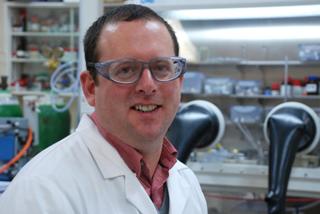Jan 6 2015
As he continues to carry out scientific research at the molecular level - holding out the prospect of nano-scale electronics that offer massive increases in processing power - the University of Huddersfield's Dr Nathan Patmore is moving directly from one major award to a prestigious new source of funding.
 A £103,000 research grant from Leverhulme Trust to look into electron transfer among hydrogen bonded dimers was issued to Dr. Nathan Patmore at University of Huddersfield. Credit: University of Huddersfield
A £103,000 research grant from Leverhulme Trust to look into electron transfer among hydrogen bonded dimers was issued to Dr. Nathan Patmore at University of Huddersfield. Credit: University of Huddersfield
He has now completed a University Research Fellowship - worth approximately £800,000 - that was awarded by the world's most venerable scientific body, the Royal Society. And now he will lead a project funded by The Leverhulme Trust, founded in 1925 and one of the largest providers of academic research funding in the UK.
The University of Huddersfield receives £103,000 for the two-year project, and the grant will enable the appointment of post-doctoral research fellow - a specialist in synthetic, inorganic chemistry - who will be based in the specially-equipped lab used by Dr Patmore and his research group at the University of Huddersfield's School of Applied Sciences.
The Leverhulme Trust award is for a project entitled Electron transfer between hydrogen bonded 'dimers of dimers'.
Dimers of dimers
These dimers are structures created when two metal atoms are bonded together. Dr Patmore's research involves the linking of two such compounds - hence "dimers of dimers". They are synthesised in the lab in strictly inert conditions, necessitating the use of an inert-gas filled "glove box".
It is research that will lead to a greater understanding of how electrons are transferred from one molecule to another and this has many implications. For example, deeper knowledge of electron transfer at a molecular level could provide a greater understanding of how cancer-forming mutations occur through electron transfer between DNA strands.
And Dr Patmore's research could lead to the creation of materials that possess new electron transfer properties. Molecular electronics would replace copper wires and silicon chips.
"If we can miniaturise electron transfer, we can get faster processing," said Dr Patmore. "It may help in designing other functional materials for a wide range of applications, such as solar energy conversion.
"It is a new field, because rather than covalent bonds we are using weaker hydrogen bonding interactions," continued Dr Patmore. "There are only a handful of models to study this and ours is perhaps best suited for looking at the process."
Dr Patmore - who is a Senior Research Fellow at the University of Huddersfield - added that one of the advantages of his research is that it closely mimics nature and the process of creating new materials will be made easier because of the use of hydrogen-bonding rather than a reliance on stronger, covalent interactions.